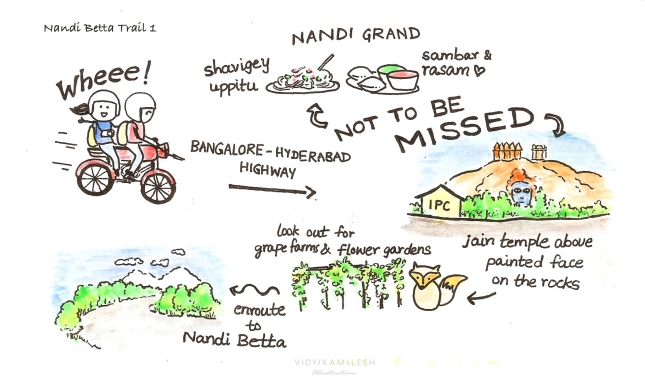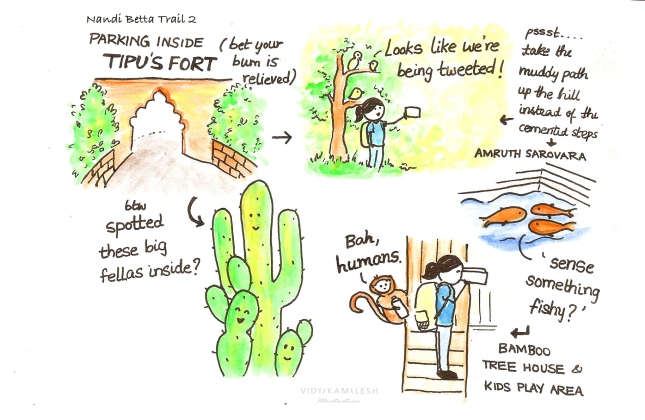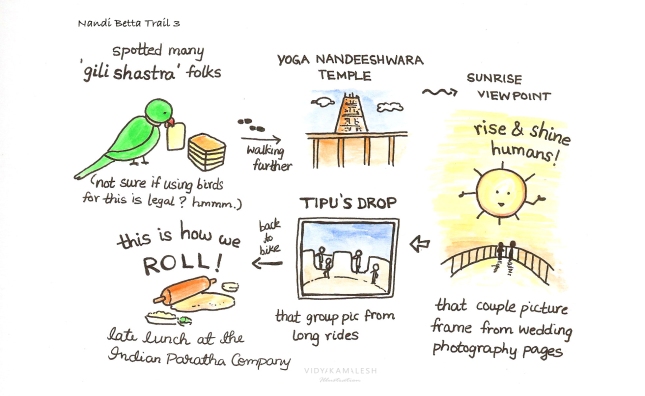
A revelation enroute to Nandi Betta
A tad bit later than our scheduled time, we were off riding to Nandi Betta over the weekend begun with a pleasant weather, not too hot as we whizzed past into the outskirts of Bangalore, away from fancy apartments, office buildings and deafening honking with slow moving traffic in some places, and into the Bangalore-Devanahalli highway. A quick breakfast at Nandi Grand on the way proved to be a great choice for the lip-smacking Sambar and tasty Shavige Uppittu we relished before we took off to reach Nandi Betta. A painted deity on a rocky hillside in Devanahalli (you’ll find it behind the Indian Paratha company) caught our attention with its stark blue and yellow colours against the sober brown surfaces, we decided to ride up and explore. And very early on the ride, this was our next best stop as we beheld the sight of the magnificent Shree Nakoda Avati 108 Parshwanth Jain Temple, after walking up from the sheltered parking area.
As the one of the temples within this sanctuary is still under construction, we had the wonderful opportunity of watching artisans meticulously carving on marble pillars forming exquisite patterns etched to perfection. The temple surfaces and statues are ravishing, and the left edge of the sanctuary houses a temple which opens to a little pillared courtyard with a ravishing view. After a delightful round of the sanctuary we headed back to the roads accompanied by vast stretches of land with cultivated flowers and grapes interspersed with small shops and the humble roadside worship spaces with a Hindu deity or two.
Hello hill fortress!

The ride up to the charming hill fortress Nandi Betta was smooth with freshly tarred roads sheltered by trees throughout the hairpin bends give you a great view of the elevated land, apart from spotting gigantic Eucalyptus trees, monkeys and plenty of birds. Arriving at Tipu’s Fort was relieving in more ways than one, especially as you’d be dying to stretch your legs. You will find a parking area as you enter the fort, followed by stairs to walk up further. We found an unusually large number of vendors selling water, juice, ice cream, cut fruits and veggies and other quick bites, perhaps cashing on the festival rush. Oh, and is anyone else a fan of cacti? You’ll totally love the ones you’ll come across as you climb up from the entrance. The climate at the hilltop has been of avid interest to horticulturists as these forests act as substrates for cloud condensation, highly favourable for the growth of moist plant and animal species. The Horticulture Department is working on setting up a large-scale exotic botanical garden among other renovations. My disappointment was scores of names scratched onto the fort wall surfaces, and on the large cacti stems as well. Further from here, you can ditch the cemented steps for a while and head up the hilltop through the foresty clearing an ideal spot for bird watchers and photographers- we definitely spotted Flycatchers and Warblers. Beware of monkeys snatching eatables and water bottles though!
It was annoying to have a bunch of youngsters storm into these clearings where many were engrossed quietly spotting birds, only to scream out and make loud intrusive noises in the otherwise peaceful natural setting. Not sure if staff appointed to dissuade this behavior, like the ones regulating traffic at the fort entrance would help or if people need to be sensitized to respecting our rich biodiversity and environment – and so thought, perhaps- the flock of flycatchers that flew away with the manmade ruckus. We reached the Amruth Sarovara, a pristine water body formed by perennial springs enclosed on its edges by steps (temple pond, also referred to as Kalyani, Pushkarini, Tirtha, etc), in which large fish swam forming ripples in the tree laden reflections. The bamboo tree houses greeted us as we reached higher up, but were unfortunately closed for entry unlike the adjacent children’s play area teeming with children, adults and the occasional monkey exploring someone’s backpack.
On top of the ascend

The final leg – walking up to the Yoga Nandeeshwara Temple, constructed by the Chola dynasty and dedicated to Lord Shiva – was flooded by devotees and vendors with carts of fruit, water and other snacks without a waste disposal system to accommodate the capacity of the generated scraps, it was extremely disheartening to see paper and plastic strewn all over the alluring hilltop. Also surprising to see the ‘Gili Shastra’ folks or soothsayers using parakeets to pick out cards and read the future, as I am not sure if it is a legal practice. Jolting through the crowd we reached the sunrise view point which is an absolute delight to walk through and be mesmerized with surreal puffs of clouds and misty air against the lush green landscapes and brown hills. Walking back is the Tipu’s Drop, known to be the spot where ruler Tipu Sultan had the condemned prisoners thrown to death. This compelling but fatal monument has a spectacular view of the hilly landscape it oversees, and these two spots seemed to be the hottest selfie spots for visitors.
Our walk downwards was blissful, flanked by the gorgeous bursts of seasonal yellow Tabebuia and lavender Jacaranda blooms, the trees interspersed with sheltered spaces for resting. We rode back for a late lunch at the Indian Paratha Company, (just ahead of the Jain temple we explored during our onward journey) before gazing through sunsets reflected on glass windows we passed by on our way back, while I reflected on the day’s experience.
It seems to have become an ‘in’ thing to post pictures of travels although I am unsure how many of us are travelling with responsibility towards the environment. A bunch of us hope to have a clean up drive to clear out the plastic and paper waste to the capacity we can, both at the hills and within the city if possible, and we would love to know if there are volunteers up for the same.




















